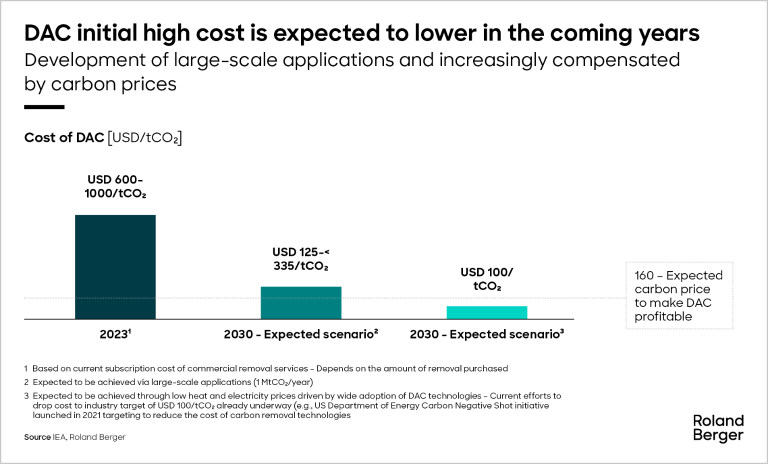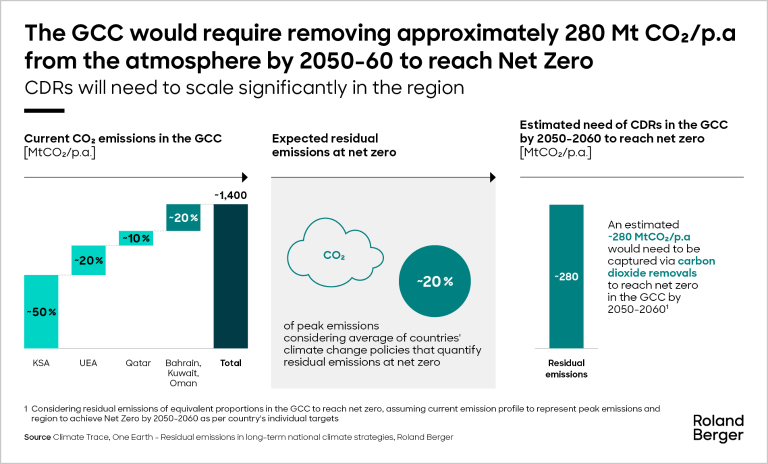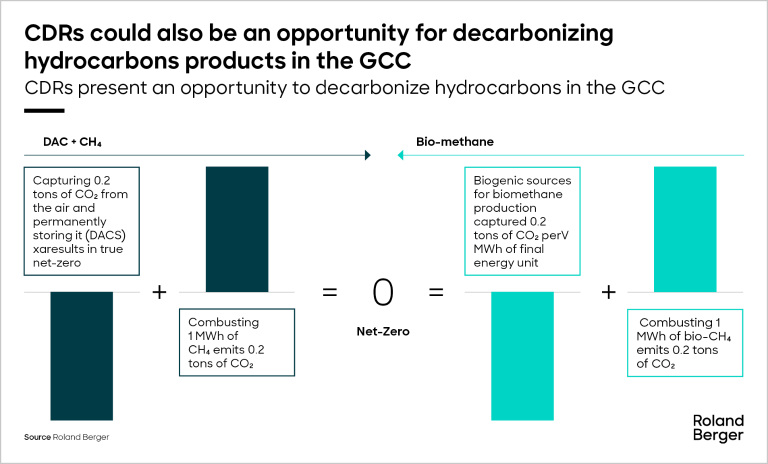Roland Berger advises public and private clients on the planning, financing, commissioning and maintenance of infrastructure.


Direct air capture as a key piece of the Net Zero puzzle in the GCC
By David Frans and Vatche Kourkejian
Scaling direct air capture technology to drive emissions reduction across the GCC
In pursuing Net Zero emissions, global strategies are increasingly centered on achieving significant reductions across various sectors [1]. These strategies emphasize the transition to low-carbon or clean energy sources, the electrification of demand in key areas (especially in road transport), and proactive measures to prevent emissions from their source, such as carbon capture, among other approaches. However, not all emissions have the potential to be reduced or avoided in the mid-term, as residual emissions could remain in hard-to-abate sectors such as aviation or heavy industries.

To achieve global Net Zero, it is necessary to reduce and avoid emissions and remove carbon dioxide from the atmosphere. Not all regions or sectors need to reach individual Net Zero targets; emissions released in one area can be balanced out by those removed through various Carbon Dioxide Removal (CDR) methods, such as direct air capture (DAC) technologies.
"In the journey to Net Zero, Direct Air Capture is the GCC’s answer to balancing rapid development with the urgent need for climate action."
The importance of CDR in reaching Net Zero
Currently, an estimated 2 billion metric tons of carbon dioxide (CO₂) are removed each year, achieved through “conventional CDRs on land [2]. These methods include creating new forests, restoring previously deforested areas, improving soil management, and utilizing more durable wood products. To achieve our climate targets, it is estimated that 450 billion) metric tons of CO₂ will need to be removed from the atmosphere by the end of the century. In the short term, this means an additional 1 billion tons of CO₂ must be removed annually by 2030.
Although current removal efforts focus on nature-based solutions, these projects carry a risk of CO₂ release over their long-term lifecycle (reversibility).
Key technologies constituting CDRs – Focus on Direct Air Capture (DAC)
CDR technologies and processes are designed to capture and eliminate excess CO₂ from the atmosphere. They are typically classified into two categories: nature-based solutions and technology-based solutions [Illustrative 1]:
- Nature-based solutions involve using natural processes, such as afforestation, reforestation, and sustainable land management, to capture and store carbon dioxide from the atmosphere.
- Technology-based solutions encompass various methods, such as DAC and bioenergy with carbon capture and storage (BECCS), leveraging advanced technologies to extract and store carbon dioxide from the atmosphere.
Technology-based solutions aim to address the limitations of traditional nature-based solutions. These limitations include a high risk of reversibility in the mid-to-long term, varying effectiveness, geographic scarcity, and challenges in measuring and verifying actual CO₂ removal.
Most technology-based solutions today are still in early development and have yet to prove to be commercially viable.
DAC solutions are emerging as front-runners in carbon removal due to successful pilot projects and their adaptable frameworks. DAC technology employs chemical processes or materials to extract CO₂ directly from the atmosphere. A common method involves using sorbents or chemical solutions that selectively capture CO₂ when exposed to air.
Latest developments on the DAC front around the world
DAC technology is still in its early stages, with only a few facilities currently in operation or under construction, capturing a total of 0.5 million tons of CO₂ per year. However, significant progress has been made in recent years, with over 30 planned projects expected to collectively capture 15 million tons of CO₂ annually by 2035 [3].
The CDR landscape features projects at various stages of development, ranging from those still in the testing phase to fully operational initiatives. Despite these differences, DAC has shown the ability to capture significant amounts of CO₂ from the atmosphere. This capability holds a promise in combating climate change by effectively removing greenhouse gases from the air.
Additionally, DAC development is attracting commercial interest as the market acknowledges its importance in achieving Net Zero targets. Companies are offering high-quality CDR credits to various corporations, including major technology firms, which have already shown interest in offsetting their emissions through captured carbon. Multiple secured deals have been established in this regard.
Currently, most transactions take place in the voluntary market because there are insufficient regulations and policies to trade within domestic, regional, or international trading schemes. The Paris Agreement limits trade of internationally transferred mitigation outcomes (such as traded emission removal credits) to bilateral agreements, which leads to a lengthy process.
CO₂ pricing is the primary factor driving the expansion of direct DAC technologies. Regulators are currently evaluating how to allow the use of negative emissions to offset CO₂ penalties. Their goal is to enable cross-country trading of negative emissions and to harmonize pricing schemes globally, which would unlock additional revenue potential for captured CO₂.
Challenges for the wide adoption and scaling of DAC
The high cost of DAC solutions currently limits the profitability of potential projects, which in turn delays the development of large-scale initiatives. The primary costs associated with DAC Capital costs and energy costs are the key costs associated with DAC, with existing systems requiring between 2 to 5 TWh to capture 1 Mt CO₂/p.a., the equivalent of the capacity of a large power plant. As a result, the cost to remove one ton of CO₂ today remains today 3-4 times higher than the threshold for commercial viability.
Governments anticipate advancements in DAC technology and are implementing various initiatives to reduce its costs and ensure commercial viability. These initiatives include government grants for specific DAC projects, government procurement programs for carbon removal credits such as the U.S. Department of Energy's CDR Purchase Pilot Prize—and research and development funding for feasibility, engineering, and design studies related to early-stage hub projects.
Recent projections indicate that technological advancements could halve DAC's cost by 2030. According to the International Energy Agency (IEA), the cost of carbon removal through DAC technologies is expected to decrease to between USD 125-335 per ton of CO₂ by 2030. Additionally, a recent partnership between a tech giant and a DAC company is based on the expectation that the DAC cost will reach around 100 USD per ton by 2030. Achieving this milestone would certainly create a promising new market.
Particularly in the GCC, DAC projects can take advantage of their close proximity to potential carbon storage hubs and access to affordable, zero-emission energy. This integration can reduce the cost of carbon removal to USD 100 per ton of CO₂. Additionally, the rapid growth of carbon pricing schemes globally will unlock new revenue streams, enhancing the profitability of DAC projects.
Call for action for GCC players
The GCC region is making significant progress toward decarbonization. Countries in the region have announced ambitious pledges to reduce emissions: the United Arab Emirates (UAE) and Oman target Net Zero by 2050, while Saudi Arabia, Bahrain, and Kuwait by 2060, and Qatar aiming for a 25% reduction in emissions by 2030.
Efforts to avoid, reduce, and capture emissions at the source are already underway in various regions. However, for large and challenging industries like cement, steel, and aluminum, the current viable and under-development technologies will not be sufficient to achieve true Net Zero in the mid-term.
The GCC countries currently emit about 1,400 Mt of CO₂ per year [4], with Saudi Arabia, the UAE, and Oman accounting for more than 80% of the region’s total emissions. Achieving Net Zero targets is essential for global climate policy, implying the need to remove carbon dioxide from the atmosphere to offset residual, hard-to-abate emissions.
On average, residual emissions account for approximately 20% of a country’s peak emissions needed to achieve Net Zero according to their climate change policies that quantify residual emissions at Net Zero [5] .
To achieve net zero emissions in the GCC, we need to consider the residual emissions of similar amounts. Assuming that the current emission levels represent peak emissions, the GCC would need to remove approximately 280 million tons of CO₂ per year from the atmosphere by 2050-2060 to reach Net Zero.
Given the regional limitations for nature-based carbon removals, achieving a reduction of approximately 280 million tons of CO₂ per year in the GCC would require the implementation of primarily technology-based CDR solutions. The required capacity for these solutions would be nearly 600 times greater than the current global DAC removal capacity. This highlights the critical need to scale up the development of this technology and encourage early adoption in the region.
In the region, there are ongoing nature-based carbon removal projects, including a significant initiative to plant 50 billion trees in the Middle East. This includes the GCC countries and parts of North Africa, as part of the Middle East Green Initiative. However, nature-based solutions are yet to demonstrate their long-term benefits and have limited applicability in the GCC compared to other regions.
Given the region’s emissions profile, expected residual emissions, and its limited capacity for nature-based carbon removal, DACs will need to be developed for the GCC to effectively meet their Net Zero commitments.
In addition to compensating for the region's residual emissions, Carbon Dioxide Removal (CDR) methods present an opportunity to create decarbonized hydrocarbon products in the Gulf Cooperation Council (GCC) countries. By removing an amount of CO₂ from the atmosphere that is equivalent to the lifecycle emissions of oil, hydrocarbon products, and fuels—this includes emissions from their combustion in end-use applications—major oil and gas companies could offer emissions-neutral products. These decarbonized hydrocarbons could serve as transitional fuels for countries and industries aiming for ambitious net-zero goals, especially where fossil fuels are still needed to utilize existing infrastructure that cannot be fully electrified or switched to alternative fuels in the short to medium term.
However, the acceptance of this approach will depend on the alignment of decarbonization strategies and climate policies across countries, necessitating international collaboration. The GCC is well-positioned to actively engage in and help shape this dialogue, promoting the development of regulatory frameworks that support innovative carbon management solutions.
The GCC has significant sources of CO₂ emissions that are primarily located along the Gulf coast of Saudi Arabia, Qatar, and the UAE. This geographic concentration presents an opportunity to adopt a hub strategy for the development of DAC technologies, in close proximity to Carbon Capture, Utilization, and Storage (CCUS) facilities and carbon-related infrastructure. By leveraging this approach, stakeholders can increase efficiency and scale, while sharing infrastructure to optimize costs.
DACs could play a crucial role in helping the GCC achieve its Net Zero targets while contributing to global decarbonization efforts. The region has the opportunity to gain an early mover advantage by establishing a supportive ecosystem for DAC technologies. This can lead to the local development and potential localization of these emerging technologies, not only for future large-scale use but also for export to other regions that will need technology-based solutions for carbon removal.
The energy transition requires various approaches, and DAC is becoming increasingly important, playing a crucial role now, and set to grow in the future. By offering DAC solutions within the GCC, the region can position itself to capitalize on this expanding market.
If we achieve one gigaton of CDR annually at the target price of USD 100 per ton, a market worth USD 100 billion could emerge. The Intergovernmental Panel on Climate Change (IPCC) forecasts indicate the need for over 10 gigatons of CDR annually, highlighting the potential for a trillion-dollar market.
The key question is: who will seize the opportunities presented by this new market? The GCC, with its vast CO₂ sequestration capacity and some of the world's lowest-cost zero-emission electricity, is well-positioned to take advantage of this opportunity.
Carbon removal is expected to grow significantly in the coming years. At Roland Berger, the firm offers extensive and up-to-date expertise in this field, backed by a successful track record of delivered projects. The firm’s support includes conducting carbon market studies to provide insights into the value chain and market economics, developing investment strategies that focus on specific geographies, value chain segments, and investment stages, as well as performing thorough target screenings of technology providers, co-investors, and due diligence, among other services.
References
[1] Based on Bloomberg Energy Transition Investment Trends 2024. Global investment in the low-carbon energy transition reached USD 1.77 trillion in 2023. This increase is mainly driven by the electrification of transport, with investments of USD 634 bn in 2023, followed by the renewable energy section and power grid investments with USD 623 bn and USD 310 bn invested respectively.
[2] IPCC and University of Oxford 2023 report: The State of Carbon Dioxide Removal
[3] Based on IEA CDR database, 2023
[4] Climate Trace
[5] One Earth, Residual emissions in long-term national climate strategies; Based on analysis of 71 long-term national climate strategies, out of which 26 quantify residual emissions at net zero.


_image_caption_none.png?v=1187666)






